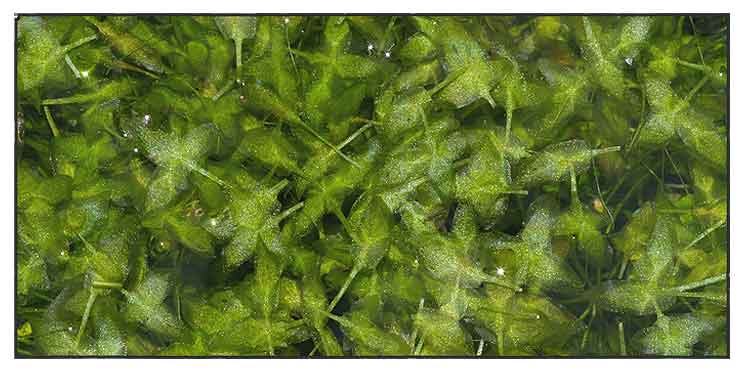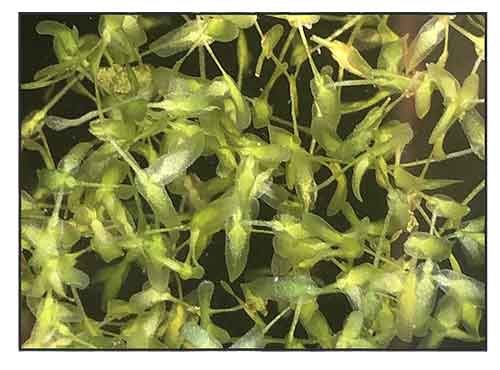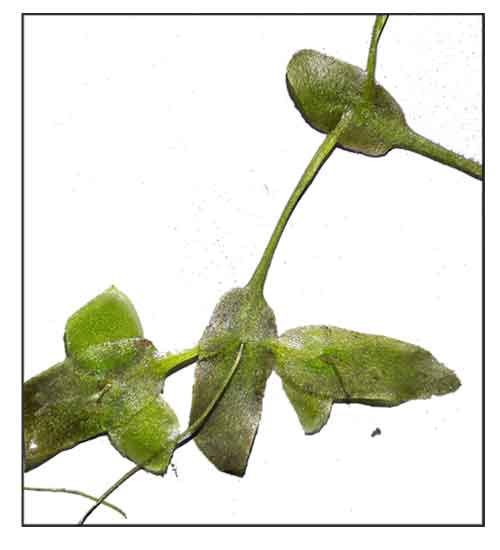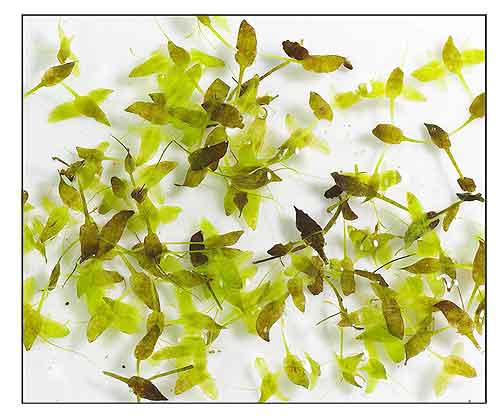 Gen info Gen info
- Lemna is a genus of free-floating aquatic plants, commonly referred to as "duckweed". Currently 14 species are recognised.
- Lemna trisulca is a species of aquatic plants in the arum family Araceae. It has a subcosmopolitan distribution. Unlike other duckweeds, it has submerged rather than floating fronds, up to 12-14 m below the surface, except when flowering or fruiting. Also, unlike other duckweeds, a large number of fronds remain attached to each other at a time. (2)
 Botany Botany
• The fronds usually grow submerged and are oblong-lanceolate in shape and are up to 14 mm long. They are blunt at the end and taper to a tail-like stalk at the other. The flowering fronds are smaller than the vegetative fronds and somewhat curl up from under the water to the surface to present the flowers (to a casual look this may cause the flowering fronds to resemble reddened duckweeds more of the L. minor format with white flower spots, with obvious greener L. trisulca directly beneath. (2)
• Fronds (except when flowering or fruiting) submersed, 3-50 coherent in one group and often forming branched chains, attenuate at base into green connecting stalk 2-20 mm, green and subhyaline, sometimes purplish, narrowly ovate to elliptic, 3-15 mm (without stalk), 2-3.5 × as long as wide, flat, without papillae on upper surface, margin denticulate distally; veins 3, rarely 1, central vein approximating apex, lateral veins ca. 1/2 of frond length. Root 0.5-2.5 cm, often lacking, sheath not winged, apex mostly pointed. Turions absent. Flowering and fruiting fronds free floating on water surface, 1-5 coherent, 3-5 mm. Ovary with 1 ovule; utricular scale with narrow opening at apex. Fruit laterally winged toward apex. Seed with 12-18 distinct ribs. (Flora of China)
 Distribution Distribution
- Native to the Philippines.
- Also native to Afghanistan, Alabama, Alaska, Albania, Alberta, Algeria, Altay, Amur, Arizona, Arkansas, Austria, Baltic States, Bangladesh, Belarus, Belgium, British Columbia, Bulgaria, Buryatiya, California, Central European Russia, China North-Central, China South-Central, China Southeast, Chita, Colorado, Connecticut, Czechia-Slovakia, Delaware, Denmark, District of Columbia, East European Russia, Finland, Florida, France, Georgia, Germany, Great Britain, Greece, Hungary, Idaho, Illinois, India, Indiana, Inner Mongolia, Iowa, Iran, Ireland, Irkutsk, Italy, Japan, Kamchatka, Kansas, Kazakhstan, Kentucky, Kenya, Khabarovsk, Kirgizstan, Krasnoyarsk, Krym, Kuril Is., Louisiana, Magadan, Maine, Manchuria, Manitoba, Maryland, Massachusetts, Mexico Central, Mexico Northeast, Mexico Southwest, Michigan, Minnesota, Mississippi, Missouri, Mongolia, Montana, Morocco, Myanmar, Nebraska, Netherlands, Nevada, New Guinea, New Hampshire, New Jersey, New Mexico, New South Wales, New York, Norfolk Is., North Carolina, North Caucasus, North Dakota, North European Russia, Northern Territory, Northwest European Russia, Norway, NW. Balkan Pen., Ohio, Oklahoma, Ontario, Oregon, Pakistan, Palestine, Pennsylvania, Poland, Portugal, Primorye, Queensland, Québec, Rhode I., Romania, Sakhalin, Sardegna, Saskatchewan, Sicilia, South Australia, South Carolina, South Dakota, South European Russia, Spain, Sumatera, Sweden, Switzerland, Tadzhikistan, Taiwan, Tanzania, Tasmania, Tennessee, Texas, Transcaucasus, Tuva, Türkey, Türkey-in-Europe, Uganda, Ukraine, Utah, Uzbekistan, Vermont, Victoria, Virginia, Washington, West Himalaya, West Siberia, West Virginia, Western Australia, Wisconsin, Wyoming, Xinjiang, Yakutiya, Yukon. (1)
Constituents
- Dry matter content of duckweed ranges from 3 to 14%. Protein content and other ingredients in dry matter vary depending on growth media quality. Protein accounts for 7-45% (most often 20-45%), fat 2-9%, fiber 12-28%, and carbohydrates 1-4% in dry matter (FAO, 1999; Iqbal, 1999;Olorunfemi et al., 2006; Hasan and Chakrabarty, 2009). (10)
 Properties Properties
- Studies have suggest bioaccumulation, water purifying properties.
Parts used
Whole plant.
Uses
Edibility
- No report on human edibility.
Folkloric
- No reported folkloric medicinal use in the Philippines.
- Used in folk medicine for its choleretic and phytoncidic activities.
- Poultice of wetted plant used for treatment of swellings.
Others
- Plant-Animal Interactions / Fodder: Plants in the Duckweed family provide food for fish, snapping turtles, and waterfowl and created habitat for aquatic invetebrates. Some species are cultivated as feed for poultry, pigs, and cows. (11)
Studies
• Use in Livestock Production and Aquaculture: Study showed that fresh and/or dried duckweed is a potential source of plant protein for farm animals and aquaculture. Use is limited by difficulties in harvesting fresh duckweed in some climatic zones and high cost of producing processed feed. (3)
• Bioaccumulation of Nickel: Aquatic plants are being used for accumulation of trace elements in natural and constructed wetlands. Study evaluated four aquatic plants for their ability to remove heavy metals from contaminated water. BCF rates for Ni were found in concentration values ranging from 576 to 1867 mg/g for Lemna trisulca. (5)
• Oxygen Production Potential and Effect of Ecological Factors: Dissolved oxygen is fundamental for chemical and biochemical processes occurring in natural waters and critical for life of aquatic organisms. Study evaluated the impact of duckweed species, L trisulca and L. minor, on dissolved oxygen content and detritus production in water and role of ecological factors (light, atmospheric pressure, conductivity, and temperature) in this process. Results showed the presence of L trisulca causes an increase in dissolved oxygen content in water. Increased in atmospheric pressure has a positive effect of duckweed oxygen production, regardless of type. L. trisulca also has highest ability to accumulate heat in water. Study provides information regarding good habitat conditions for duckweed and its role in purifying water reservoirs. (6)
• Suitability for Water Purification / Coagulant and Disinfectant: Study evaluated the effectiveness of duckweed as coagulant/disinfectant in the treatment of water and wastewater. Results showed Duckweed plant is an effective coagulant and disinfectant. Treatment of water using duckweed filtrate showed an edge over duckweed powder for average % bacteria removal, 91% to 82% respectively. For coagulation (turbidity and suspended solid removal), average percentage removal for filtrate and powder was 84.3% and 80.% respectively. This natural plant can provide a cheap, consistent supply of high quality water all year round because of its availability. Duckweed filtrate and powder should be used for drinking and graywater respectively, since filtrate is more effective than powder. Treated water should be flocculated and left to stand undisturbed for 30 minutes before usage for optimum performance. (7)
• Phytoremediator for Removal of Zinc Oxide Nanoparticles: Nanoparticles (NMs), especially those of zinc oxide (ZnONPs), are of concern because of increasing presence in the environment, posing risks to biota and human health. Study evaluated the capacity of Lemna trisulca, a submerged macrophyte, for removal of ZnONPs. Results showed L. trisulca can be used for ZnONP removal for short incubation times with maximum removal rate of 73%. More studies were suggested to understand aggregation resuspension, and key removal mechanisms, and to discriminate between internalized and adsorbed NPs. (8)
• Phytoremediation and Tolerance to Cyanotoxin Anatoxin-a: Previous studies have reported anatoxin-a (ANTX-a) accumulation and bioremediation by Lemna trisulca. Study showed the cultivation of the macrophyte in medium containing ANTX-a at concentration similar in nature (1.0 mu g.mL) did not cause any changes in plant physiology. A higher toxin concentration(12.5 mu) reduced photosynthetic efficiency by 27% compared with control, but had no significant effect on respiration response. Further studies showed no significant differences in enzymatic activity of SOD, catalase, ascorbate peroxidase, glutathione peroxidase, and glutathione reductase, regardless of ANTX-a concentrations in the media. Results confirm L. trisulca has high tolerance to the toxin and has great potential as phytoremediation agent in aquatic environments. (9)
• Duckweed as Supplement Feed: While duckweed is effective in absorbing various components from the aquatic environment, including harmful heavy metals, according to FAO'a 1999 report, content of elements such as Cd, N, Cr, Zn, Sr, Co, Fe. Mn, Pb, Al, and Au in duckweed do not pose threat to human or animal health, and can be used as supplement in feed mixtures for poultry and livestock. Duckweed is commercially produced in some tropical countries, where meal is produced after dehydration and de-oiling. It is often fed to animals in the form of naturall green biomass. It can provide 4 to 5 times as much protein per hectare as soybean cultivation does. Also, it is not genetically modified, contains no gluten, and requires no farmland nor chemical fertilizers. However, because duckweed accumulates many heavy metals, levels should be monitored during duckweed production for feedstuffs. (see constituents above) (10)
Availability
- Wild-crafted. |

![]()






 Properties
Properties